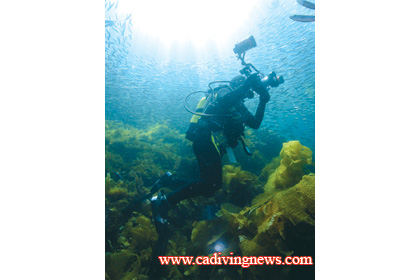Body Posture and Movements in Underwater Photography by Dale Sheckler
There are a lot of tools in underwater photography—various cameras, lenses, strobes and more. But there is a tool that most underwater photographers rarely consider—their own body. How you move and posture your body can have a huge effect on the success of your underwater photo expedition, even on your safety. Below are few tips on how to maximize the largest and perhaps the most important tool in your underwater photography arsenal — your body.
LOW AND SLOW
Probably two-thirds of the creatures you will try to photograph in the underwater realm will not let you approach or at least not sit still. When you approach from above, you will cast a shadow on the subject matter or present a large silhouette against the light surface background. You will, in short, appear to be a large predator dropping down to pounce on them. They will flee. The trick: get low and move slowly. Getting low will not only eliminate the large foreboding figuring it will reduce your body profile to one of a much smaller, head on view. Moving slowly will also present you as less of a threat. Slow movement will allow you to bring your breathing down to a slow, rhythmic pace. While this will not eliminate the roar of your bubbles, the steadier breathing pattern gives your subject something easier to get used to.
SHOOT UP
I am repeating myself on the point of getting low because this will usually also give you a superior camera angle. You’ll be able to get a better choice of background, and your photo will take on a more three-dimensional look. You will often be able to approach the marine life head on for fascinating perspective. Shooting up will give you better opportunity for a light blue (a green) water background, giving the photo a more natural look.
WATCH YOUR EYE CONTACT
Most skittish marine life are very sensitive to eye contact from other marine creatures, including the underwater photographer. If you just can’t seem to get close to a particular fish, try approaching it from an angle where it cannot see your eyes. Try a sideways angle where you are looking out your mask at an angle. Your camera lens can also appear as a big eye so be aware of this also as you approach your subject.
STAY OFF THE REEF/BUOYANCY CONTROL
Body contact with the reef, especially coral reefs, is a no-no. Let’s keep the reefs alive and well. Superior buoyancy skills are a must. It is also important in a kelp forest, as it is easy to lose track of where your body is leading to possible entanglement. Not only that, your buoyancy must be balanced for effortless body position, whatever might be desired, either vertical or horizontal.
There are, however, exceptions to this rule. If you know you can settle down onto a clean sand bottom next to your subject, it might be to your advantage to be slightly negatively buoyant.
DON’T STIR UP THE MUCK
This is where most divers struggle. Move gently and use proper buoyancy control. Be aware of your body movements and what parts of your body are touching the sand or mud. If there is a current, even slight, and it is appropriate, approach your subject down current. Not only are you less likely to disturb your subject with your “smell,” any particles you stir up will drift away from you. Also be careful not to stir up the muck when you leave the scene as your next subject might be close by or another photographer might be right behind you. And finally, make sure your buddy is also aware to not kick the crud up off the bottom.
SAFETY ISSUES
First and foremost, don’t hold your breath! Underwater photographers have embolized holding their breath while trying to steady their camera underwater. Breathe rhythmically and slowly with your best bet for a steady camera being on a gentle inhalation.
Buddy systems often break down horribly when two underwater photographers are involved but it need not be so. Pre-dive planning is a must. Discuss goals — a particular creature, macro or wide-angle, a specific dive path, etc. Agree on a minimum distance from each other. Then you just need to keep each other in sight and slow down your pace. Just as important is to work together. Two pairs of eyes are better than one in spotting subject material. After you spot a good subject, point it out to your buddy to give them also a chance to give it a shot.
The largest piece of underwater photography gear you’ll own is your body. Use it to your advantage, not as a hindrance.









